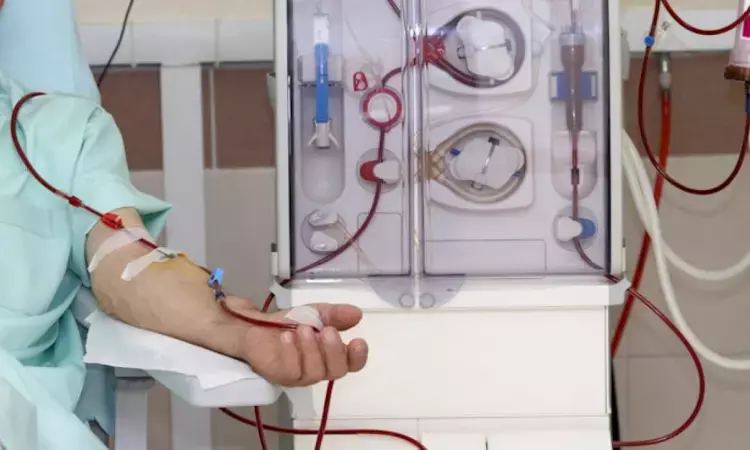- Home
- Medical news & Guidelines
- Anesthesiology
- Cardiology and CTVS
- Critical Care
- Dentistry
- Dermatology
- Diabetes and Endocrinology
- ENT
- Gastroenterology
- Medicine
- Nephrology
- Neurology
- Obstretics-Gynaecology
- Oncology
- Ophthalmology
- Orthopaedics
- Pediatrics-Neonatology
- Psychiatry
- Pulmonology
- Radiology
- Surgery
- Urology
- Laboratory Medicine
- Diet
- Nursing
- Paramedical
- Physiotherapy
- Health news
- Fact Check
- Bone Health Fact Check
- Brain Health Fact Check
- Cancer Related Fact Check
- Child Care Fact Check
- Dental and oral health fact check
- Diabetes and metabolic health fact check
- Diet and Nutrition Fact Check
- Eye and ENT Care Fact Check
- Fitness fact check
- Gut health fact check
- Heart health fact check
- Kidney health fact check
- Medical education fact check
- Men's health fact check
- Respiratory fact check
- Skin and hair care fact check
- Vaccine and Immunization fact check
- Women's health fact check
- AYUSH
- State News
- Andaman and Nicobar Islands
- Andhra Pradesh
- Arunachal Pradesh
- Assam
- Bihar
- Chandigarh
- Chattisgarh
- Dadra and Nagar Haveli
- Daman and Diu
- Delhi
- Goa
- Gujarat
- Haryana
- Himachal Pradesh
- Jammu & Kashmir
- Jharkhand
- Karnataka
- Kerala
- Ladakh
- Lakshadweep
- Madhya Pradesh
- Maharashtra
- Manipur
- Meghalaya
- Mizoram
- Nagaland
- Odisha
- Puducherry
- Punjab
- Rajasthan
- Sikkim
- Tamil Nadu
- Telangana
- Tripura
- Uttar Pradesh
- Uttrakhand
- West Bengal
- Medical Education
- Industry
IV contrast administration through CT increases hemodialysis risk after traumatic injury: Study

Chapel Hill, NC: A new study states that intravascular contrast delivery by computed tomography or angiography is related to an increased likelihood of requiring hemodialysis following a traumatic injury. The findings of this work were published in the Surgery journal on 25th October 2021.
Contrast is routinely administered to trauma patients for diagnostic and therapeutic purposes. Andrew Schneider and the team conducted the study with an objective to look into the prevalence and factors of contrast-induced nephropathy necessitating immediate hemodialysis in the trauma population.
For this study adult patients (age 16) were identified from the National Trauma Databank (2017-2018) and were classified depending on the contrast received. No contrast, computed tomography intravascular contrast alone, and angiography contrast were the designated groups. The following patient demographic and clinical information were collected: injury severity score, shock index, Glasgow Coma Scale, and mechanism.
Mortality, hospital discharge disposition, intensive care unit and hospital duration of stay, and requirement for hemodialysis were among the outcome indicators assessed. Admission to the hospital. Finally, the researchers used Poisson regression to determine the relative chance of getting hemodialysis during hospitalization.
The final results were stated as follows, in all, 1,850,460 individuals were included in the analysis, with 3,135 requiring hemodialysis throughout their stay. Patients with a lower Glasgow Coma Scale, a greater injury severity score, a higher shock index, and a history of diabetes and hypertension were more likely to require hemodialysis. The relative risk of needing hemodialysis was shown to be 1.49 with computed tomography intravascular contrast alone, 4.33 with angiography alone, and 5.35 with sequential computed tomography intravascular and angiography.
In conclusion, trauma surgeons should examine the need for contrast in each clinical circumstance and be aware of the risk of contrast-induced nephropathy.
Reference:
Schneider, A., Gallaher, J., Purcell, L. N., Raff, L., Eckert, M., & Charles, A. (2021). Risk of acute kidney injury requiring hemodialysis after contrast-enhanced imaging after traumatic injury: A National Trauma Databank analysis. In Surgery. Elsevier BV. https://doi.org/10.1016/j.surg.2021.08.056
Medical Dialogues consists of a team of passionate medical/scientific writers, led by doctors and healthcare researchers. Our team efforts to bring you updated and timely news about the important happenings of the medical and healthcare sector. Our editorial team can be reached at editorial@medicaldialogues.in.
Dr Kamal Kant Kohli-MBBS, DTCD- a chest specialist with more than 30 years of practice and a flair for writing clinical articles, Dr Kamal Kant Kohli joined Medical Dialogues as a Chief Editor of Medical News. Besides writing articles, as an editor, he proofreads and verifies all the medical content published on Medical Dialogues including those coming from journals, studies,medical conferences,guidelines etc. Email: drkohli@medicaldialogues.in. Contact no. 011-43720751


